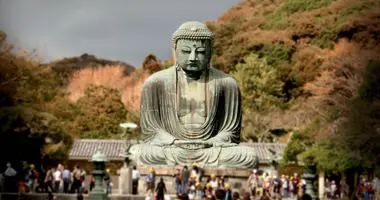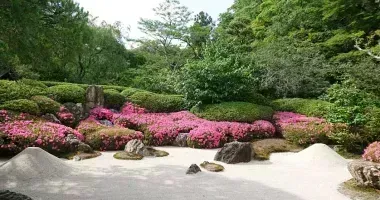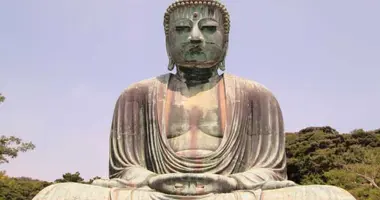Meigetsu-in Temple: A serene Zen sanctuary in Kamakura
- Published on : 16/06/2024
- by : Japan Experience
- Youtube
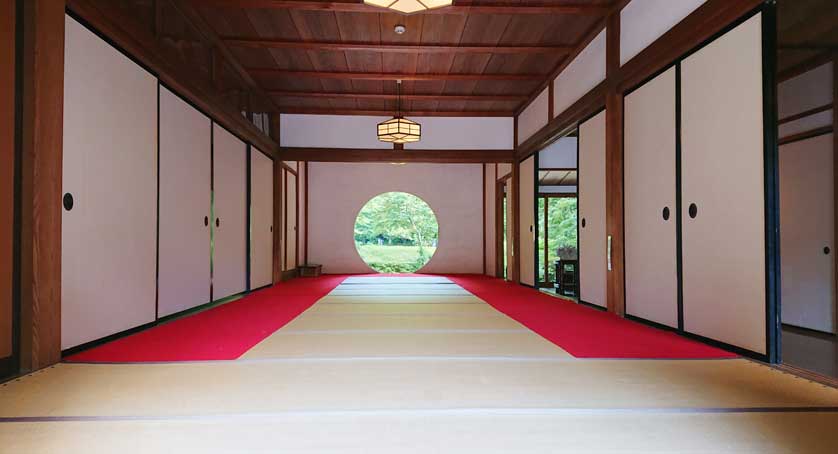
Great Hall inside the Main Building of Meigetsu-in
Nestled in the historic city of Kamakura, Meigetsu-in Temple stands as a captivating testament to Japan's rich Buddhist heritage. Known affectionately as the "Temple of Hydrangeas," this Rinzai Zen temple offers visitors a harmonious blend of spiritual tranquility and natural beauty. With its stunning gardens, unique architectural features, and deep historical significance, Meigetsu-in provides a serene escape from the bustling world outside its gates. Whether you're drawn by the vibrant blooms of summer, the fiery foliage of autumn, or the temple's year-round charm, a visit to Meigetsu-in promises a memorable journey into the heart of Japanese culture and aesthetics.
History and significance of Meigetsu-in Temple
Meigetsu-in Temple boasts a rich history dating back to 1160, when it was founded as a hermitage called Meigetsu-an ("Bright Moon Hermitage"). The temple was established by Yamanouchi Tsunetoshi to honor his father, Toshimichi, who perished in the Heiji Rebellion during the tumultuous power struggles of the late Heian Period.
Over the centuries, Meigetsu-in's fortunes waxed and waned with the tides of history. It became part of the larger Zenkoji Temple complex, gaining prestige as one of the Kantō Jissetsu, a group of ten important Rinzai Zen temples in the region. However, the temple faced significant challenges during the Meiji Restoration in 1868, when anti-Buddhist sentiment led to the dismantling of many religious institutions. Zenkoji was abolished, but Meigetsu-in managed to survive as an individual temple, preserving its legacy and spiritual importance.
One of the most significant historical figures associated with Meigetsu-in is Hojo Tokiyori, the fifth regent of the Kamakura Shogunate. In 1256, at the age of 30, Tokiyori retired from his position as regent and entered the Buddhist priesthood under the name Kakuryobo Dosu. He chose the site of Meigetsu-in to build a small temple called Saimyoji, though this was later abandoned after his death. Today, Tokiyori's tomb can still be found on the temple grounds, serving as a tangible link to Kamakura's golden age of samurai rule.
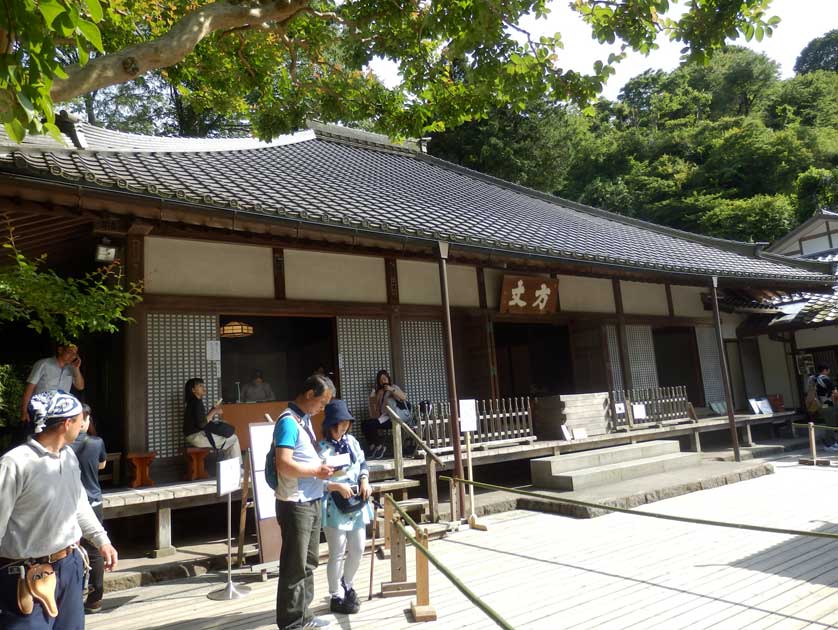
Main Building, Hondo, of Meigetsu-in Temple
Exploring the temple grounds and main attractions
As you walk to Meigetsu-in Temple, you'll find yourself immersed in the tranquil atmosphere of Kamakura's Yamanouchi district. The approach to the temple takes you along a narrow river, past traditional estates with high walls and lush gardens. This picturesque setting once inspired legendary film director Yasujiro Ozu, who lived nearby in his later years.
Upon entering the temple grounds, visitors are greeted by the sight of the Main Hall (Hondo), which features a striking circular window known as the "Window of Enlightenment" or Satori no Mado. This unique architectural element frames the inner garden beautifully, creating a living picture that changes with the seasons. The window's round shape symbolizes completeness and perfection in Buddhist philosophy.
Near the Main Hall, you'll find the Founder's Hall (Soyu-do), a thatched-roof building dating back to around 1380. This important structure enshrines the temple's founder and houses the mortuary tablets of successive head priests. Adjacent to the Founder's Hall is a large yagura cave, one of the biggest in Kamakura. These caves, carved into the hillsides, served as tombs and are a distinctive feature of Kamakura's temple architecture.
The temple grounds also include other noteworthy features:
- A traditional karesansui (dry landscape) garden in front of the Main Hall, representing Mount Shumisen from Buddhist cosmology
- The Kame no I well, one of the famous Ten Wells of Kamakura
- A small pond behind the Main Hall, adding to the serene atmosphere of the inner garden
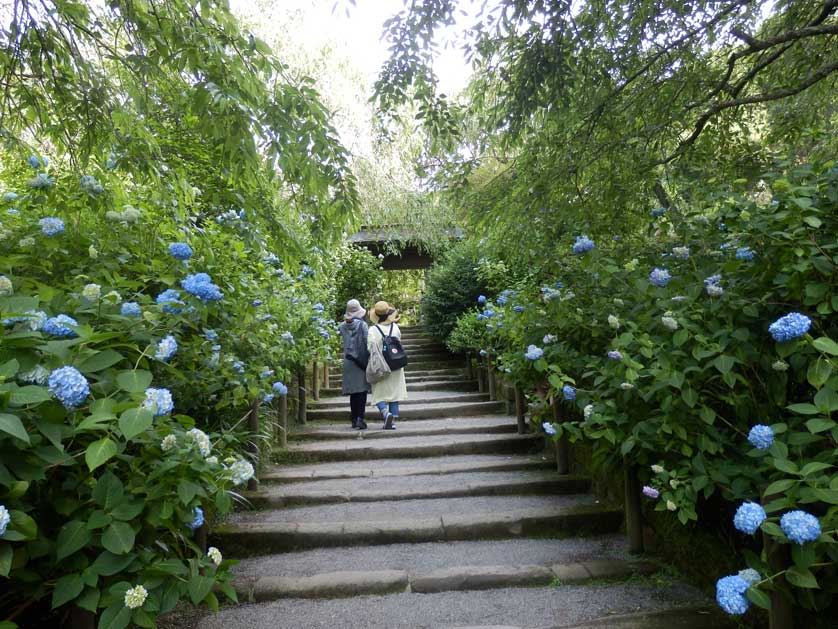
Weathered Stone Staircase with hydrangea, Meigetsu-in Temple, Kamakura
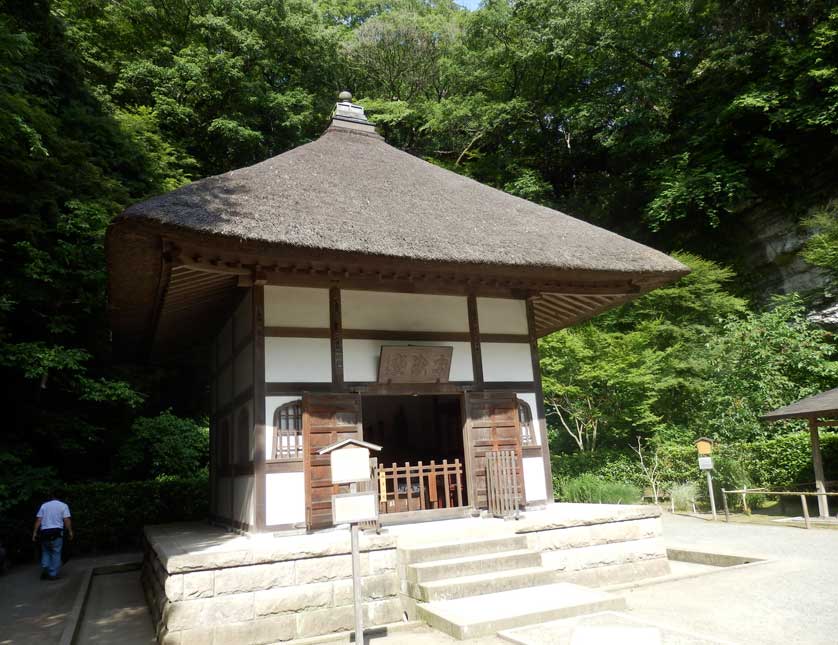
Founders Hall (Soyu-do) at Meigetsu-in
The famous hydrangeas and seasonal beauty
Meigetsu-in is perhaps best known as the "Temple of Flowers," a nickname it has earned due to its spectacular display of hydrangeas (ajisai in Japanese) during the early summer months. The temple grounds boast over 2,500 hydrangea bushes, with about 95% belonging to the Hime Ajisai ("Princess Hydrangea") variety, known for their vivid blue color.
The flower season at Meigetsu-in reaches its peak in June and early July, coinciding with Japan's rainy season. During this time, the temple becomes a breathtaking sea of blue blooms, drawing visitors from far and wide. The iconic image of Meigetsu-in is its weathered stone staircase flanked by blue hydrangeas, creating a stunning visual contrast.
While the hydrangeas are undoubtedly the stars of the show, Meigetsu-in's floral beauty extends beyond the early summer months:
- Spring: The garden comes alive with cherry blossoms, azaleas, and other spring flowers
- Autumn: The temple grounds are transformed by the vibrant colors of fall foliage
- Winter: Even in the colder months, the garden offers subtle beauty with wintersweet blossoms
For those visiting during the hydrangea season, the experience is enhanced by the sight of visitors in traditional kimono carrying traditional umbrellas, creating a picturesque scene that seems to transport you back in time.
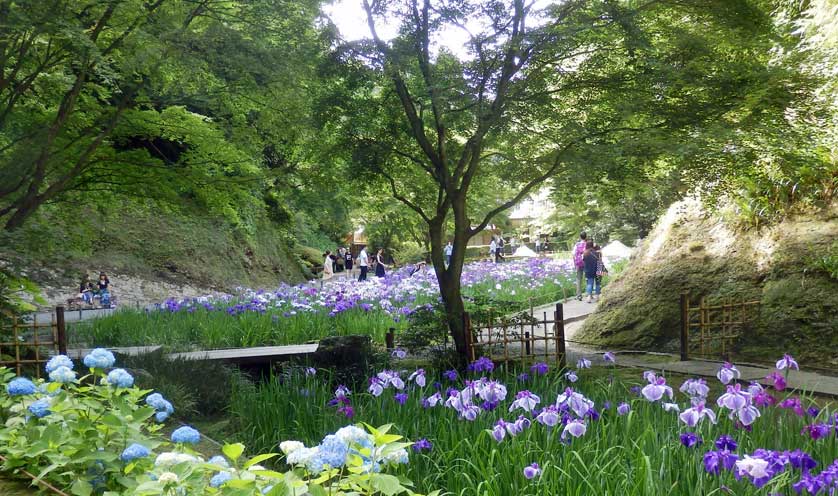
Hydrangea and iris in the Inner Garden, Meigetsu-in Temple
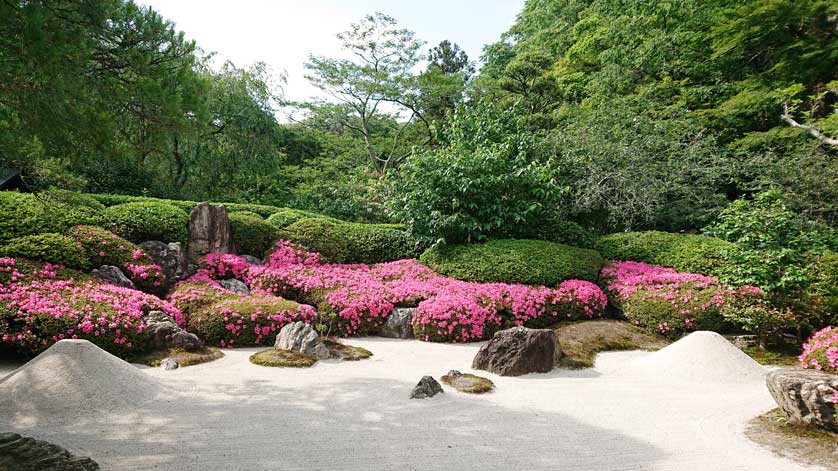
Stone / gravel garden with blooming azalea, Meigetsu-in Temple
Unique features: Circular window and inner garden
One of Meigetsu-in's most distinctive features is its famous circular window in the Main Hall. This "Window of Enlightenment" offers a perfectly framed view of the inner garden, creating a living picture that changes with the seasons. The window's design is not just aesthetically pleasing but also deeply symbolic, representing the Buddhist concept of enlightenment and the cycle of rebirth.
Behind the Main Hall lies the inner garden, a hidden gem that is only open to visitors during two special periods each year. In June, when the irises are in bloom, and in late November to early December, when the autumn colors are at their peak, visitors can pay an additional fee to explore this secluded area. The inner garden features:
- A small pond reflecting the surrounding nature
- Beds of vibrant irises in various hues
- Carefully manicured paths that wind through the landscape
- A backdrop of lush greenery that transforms into a canvas of reds and golds in autumn
The limited access to the inner garden adds to its allure, making it a special treat for those lucky enough to visit during these brief windows of time. From this secluded spot, visitors can also enjoy a unique perspective of the Main Hall's circular window from the outside, appreciating its architectural beauty in a new light.
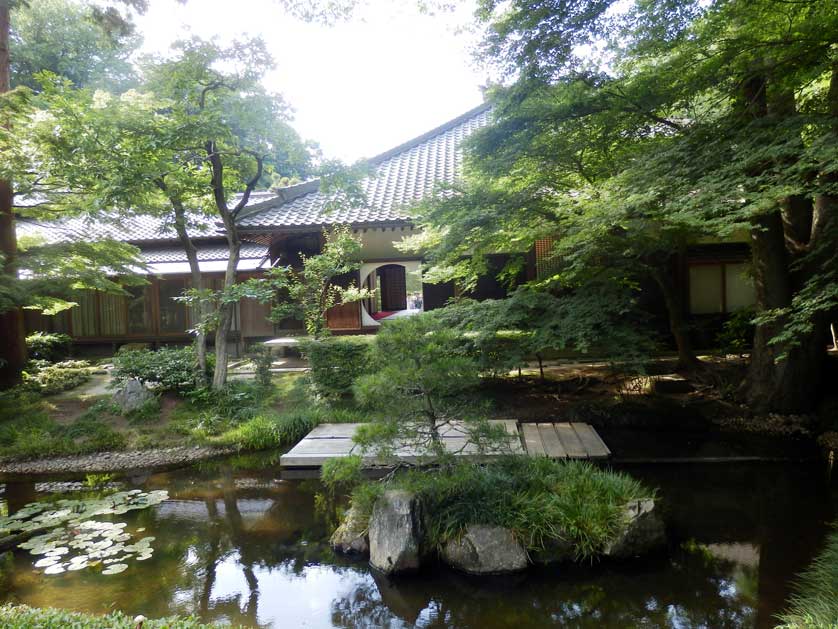
Main Building with its characteristic round window seen from the Inner Garden
Spiritual and cultural aspects of Meigetsu-in
Meigetsu-in belongs to the Rinzai Zen Buddhism tradition, specifically the Kenchō-ji school. This lineage emphasizes rigorous meditation practices and the use of koans (paradoxical questions or statements) to achieve enlightenment. The temple's serene atmosphere and carefully designed gardens reflect these Zen principles, inviting visitors to engage in quiet contemplation and mindfulness.
The temple's name, Meigetsu-in, translates to "Bright Moon Temple," and this lunar connection is reflected in various aspects of the temple's design and symbolism. In Japanese folklore, rabbits are associated with the moon, and visitors will notice rabbit motifs scattered throughout the temple grounds. Some real rabbits are even kept in enclosures, adding a touch of whimsy to the spiritual setting.
Meigetsu-in also houses several important cultural treasures, including:
- A 13th-century statue of Uesugi Shigefusa, founder of the Uesugi clan, dressed in the attire of Kamakura-period dignitaries
- The main object of worship, a statue of Shō Kannon (Avalokiteśvara), the bodhisattva of compassion
- Historic tatami-floored halls that offer a glimpse into traditional Japanese architecture
Visitors can participate in various cultural activities at the temple, such as enjoying matcha green tea and traditional sweets at the on-site tea house, or writing wishes on ema (wooden plaques) decorated with blue hydrangea motifs.
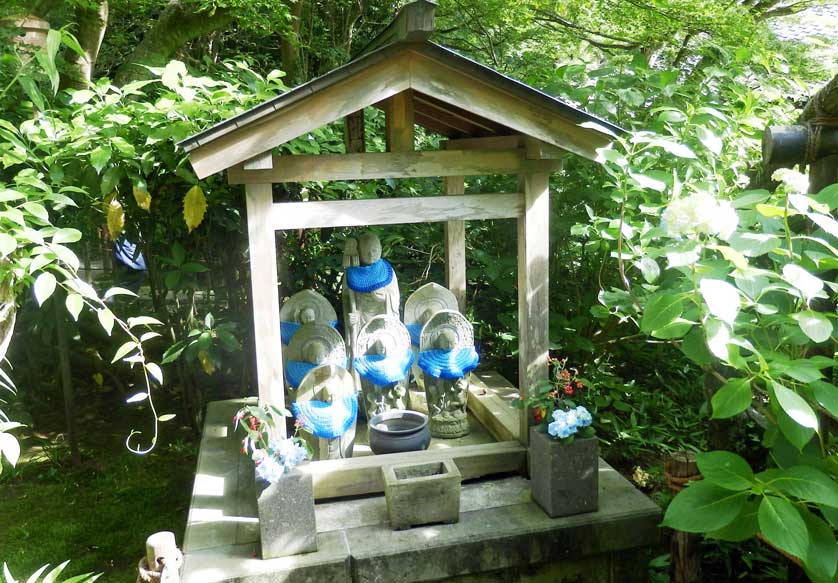
Ojizo-sama statues dressed in blue, Meigetsu-in Temple, Kamakura
Practical information for visitors
To make the most of your visit to Meigetsu-in Temple, consider the following practical information:
Access: The temple is located about a 10-minute walk from Kita-Kamakura Station on the JR Yokosuka Line. From Tokyo, the journey takes approximately 50 minutes.
Opening hours:
- March to November: 9:00 AM to 4:00 PM
- December to February: 9:00 AM to 3:30 PM
- June (hydrangea season): 8:30 AM to 5:00 PM
Admission fees:
- General admission: 300 yen
- June (hydrangea season): 500 yen
- Inner garden (when open): Additional 500 yen
Best times to visit:
- Early June to early July for hydrangeas
- Late November to early December for autumn colors
- Weekdays to avoid crowds, especially during peak seasons
Tips for visitors:
- Arrive early, especially during hydrangea season, to avoid long queues
- Bring an umbrella during the rainy season (June-July)
- Consider visiting in the morning or late afternoon for the best lighting for photography
- Respect the temple's rules and maintain a quiet, respectful demeanor
Nearby attractions and things to do in Kamakura
Meigetsu-in is just one of many fascinating attractions in Kamakura, a city rich in history and natural beauty. After exploring the temple, consider visiting these nearby sites:
- Engakuji: Another major Zen temple, known for its large temple bell and beautiful grounds
- Tokeiji: A temple with a unique history as a sanctuary for women seeking divorce
- Kōtoku-in: Home to the famous Great Buddha of Kamakura, a massive bronze statue dating back to the 13th century
- Hase-dera: A temple featuring a large wooden statue of Kannon and offering panoramic views of Kamakura
- Kamakura's beaches: Perfect for a relaxing afternoon by the sea after temple-hopping
For those interested in hiking, the Daibutsu Hiking Course is a popular trail that connects various temples and offers beautiful views of the surrounding nature. The course starts near Kita-Kamakura Station and ends near the Great Buddha, making it an excellent way to explore the area on foot.
Kamakura also offers numerous opportunities to experience traditional Japanese culture, from trying local culinary specialties to shopping for artisanal crafts. The city's compact size makes it ideal for a day trip from Tokyo, but staying overnight allows for a more leisurely exploration of its many charms.
Whether you're a history enthusiast, a nature lover, or simply seeking a peaceful retreat, Meigetsu-in Temple and its surroundings offer a rich tapestry of experiences that capture the essence of Japan's cultural heritage. As you wander through the temple's hydrangea-lined paths or gaze upon the perfectly framed garden through its circular window, you'll find yourself transported to a world where nature, history, and spirituality intertwine in perfect harmony.
